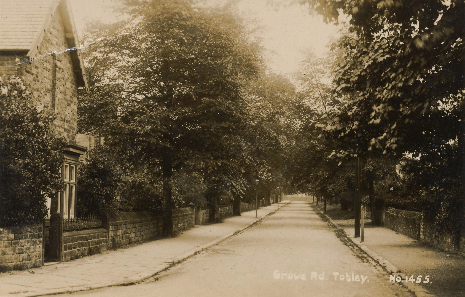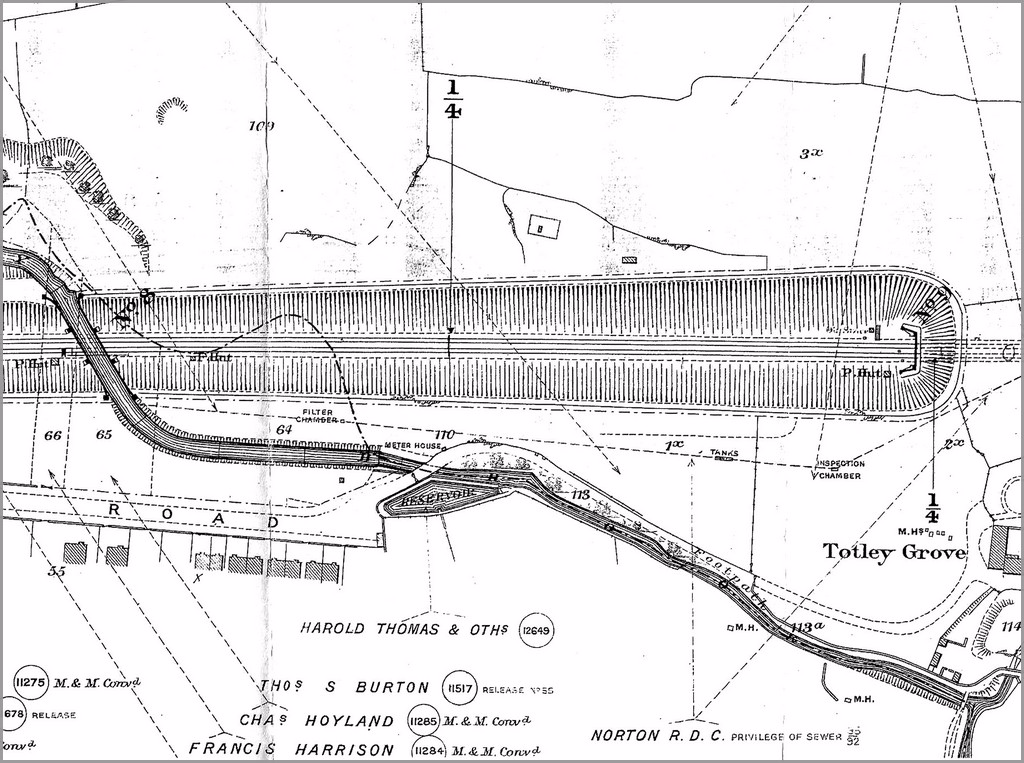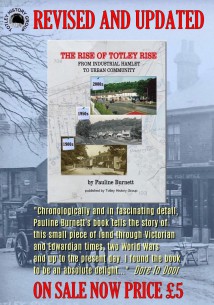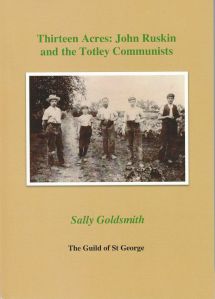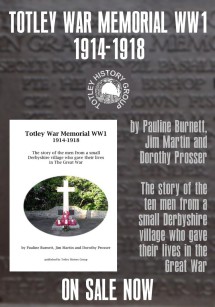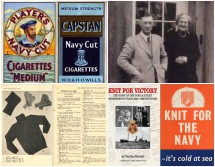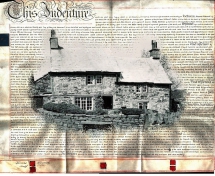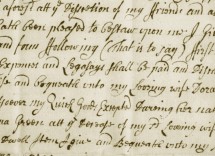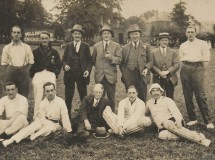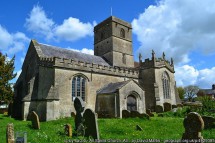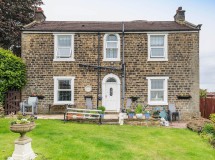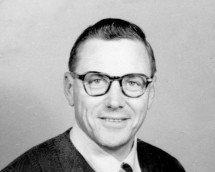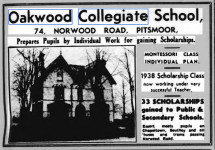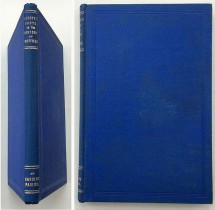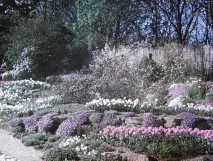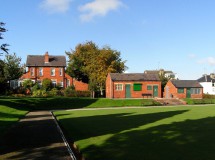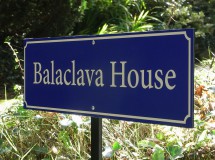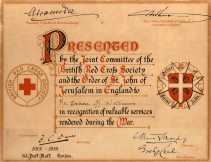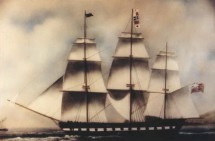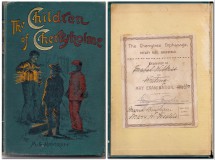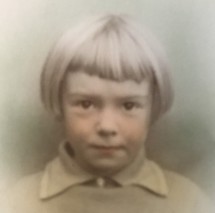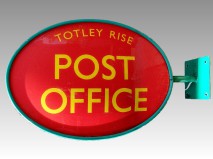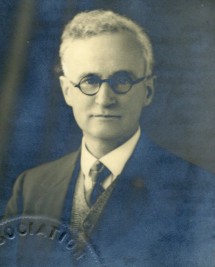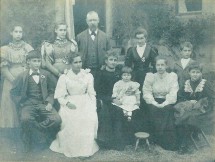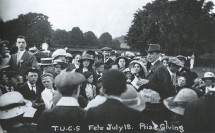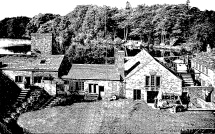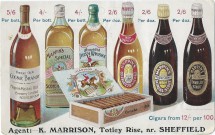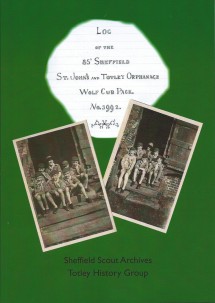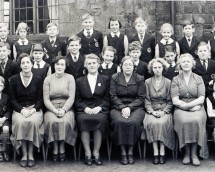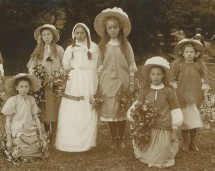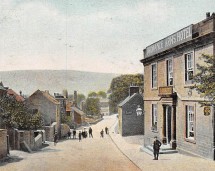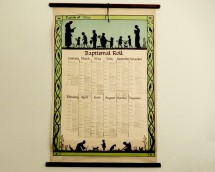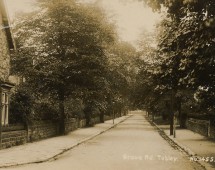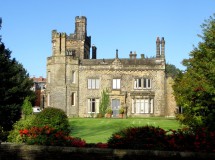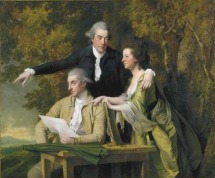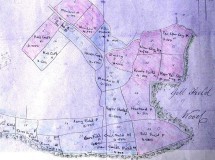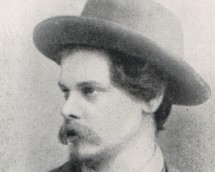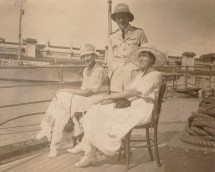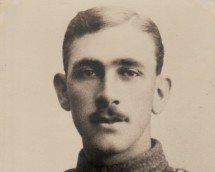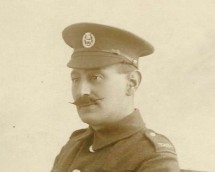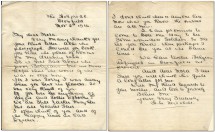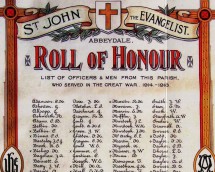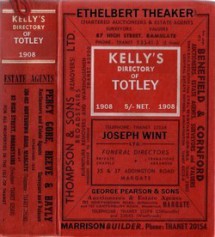Grove Road and the Totley Brook Estate
Following an enquiry from a resident, we have been looking into the history of Grove Road and the first Totley Brook Estate. The land that later became the original Totley Brook Estate had been owned in the early 19th century by the Duke of Devonshire before it was acquired for development by Mr Edmund H. Sanderson, a Sheffield estate agent, in 1873.
A Freehold Land Society, the Totley Brook Estate Company, was formed and its inaugural meeting was held on 12 June 1873 at the Royal Hotel, Abbeydale Road, Highfield, when a committee of nine was appointed to manage the estate. The Chairman was Mr Fairmaner of Cemetery Road, Sheffield, and the remainder were professional men, small businessmen and manufacturers.
Freehold Land Societies played an important part in the urban development of 19th century England. They differed from Building Societies in that they were not dealing with negotiations for single properties, but with the development of estates. In some cases there was a political element to the society in the provision of homes for the ‘working man’. In encouraging the population to acquire their own homes, this also made them eligible to vote. There was also the better ordered environment for the professional and business classes in the planned estate, which led to the ‘garden city’ and ‘garden suburb’ of the early 20th century.
An early development was to plan out the estate into allotments, to remove the dam and construct it elsewhere, and to sell the plots. The construction of a dam and reservoir at what is now the entrance to the back drive to Grove House was advertised:
Saturday 23rd August 1873 Sheffield Daily Telegraph (page 4)
Contracts
Contractors willing to Tender for the Construction of a Reservoir for the Totley Brook Estate, Abbeydale, can inspect the Plans at my Offices, from Monday, the 25th of August, to Monday, the
1st of September, on which latter day Tenders must be delivered to me not later than One o'clock. J.B. Mitchell-Withers, Architect, St. James'-street, Sheffield.
A tender of £275 was accepted from Mr Reuben Clarke and Mr Harvey was appointed as auctioneer at a fee of £3 3s. 0d. The auction of the plots took place at the Royal Hotel on 15 September 1873. All 105 plots were sold at prices ranging from 5s. to £24.
There were thefts and vandalism on the site, In February 1874, two guineas was paid for the cost of prosecuting Peter Pinder for committing wilful damage to a fence wall. Several committee meetings were cancelled due to poor attendance, causing the introduction of fines of 3 pence if members were more than 15 minutes late for meetings and 6 pence in the event of failure to attend ‘except in the case of sickness or absence more than six miles from Town.’
A road was built through the estate from the main road to Baslow by 1875.
Saturday 12th June 1875 Sheffield Daily Telegraph (page 5)
Totley. To be Sold, two Plots of Land, lying together, forming part of the Totley Brook Estate, running from the newly-formed road to the Brook side.
Water pipes have recently been laid down, by which water from the Estate's Reservoir is conveyed to each plot, and a good supply of water will thus be obtained free of cost. - Apply Elias Needham,
Accountant, Norfolk-street.
At this time roads in rural areas didn’t have formal names. Local authorities had no responsibility for erecting road name signs until after 1925. The road to Baslow, for example, was called variously “the Baslow road”, “Abbeydale road”, “Main road”, or “the Turnpike road” (they always used lower case in those days). The new road, which was really an improvement to the back drive to Totley Grove, was referred to as “the Totley Brook Estate road” or simply “Totley Brook road”. This road connected the plots on the estate to the main Baslow road at the corner shown on the 1876 plan i.e. at Grove Lodge (built as a lodge to Totley Grove in 1836).
The estate road was severed by the building of the railway line and it was only in 1892 that a new stretch of road to the north of the railway line was built to connect the severed western end of the estate road with Abbeydale Road. The name “Totley Brook Road” then became used for the road as we know it now and “Totley Grove road”, later “Grove road”, was used for the truncated eastern section of the estate road although people still referred to it by its old name well into the new century.
Totley and Dore in those days were attractive places to visit at weekend for city dwellers, with fresh air, walks on the moors and numerous pubs and ale houses. The opening of Dore & Totley Railway Station in 1872 had made the journey time much shorter and people came in huge numbers:
26th May 1877 Weekly Supplement to the Sheffield Daily Telegraph
Local Railway Traffic
On Monday, there was a great increase in the railway traffic to and from both the Midland and Victoria Stations. From the former station there went 30 passengers to Scotland, 350 to London, 170 to
Birmingham, 220 to Morecambe, 180 to Nottingham, 400 to Matlock and 2,000 to Dore, Totley and Beauchief.
Property was being built along Abbeydale, moving ever further from the city. Joseph Mountain was one such land owner and builder who had housing estate schemes at Millhouses, Beauchief, Abbeydale Park and Totley Rise culminating in the opening of the Victoria Gardens in 1883 which attracted even more people to area. Lying outside the city and county boundaries, rates were lower in Derbyshire than in Sheffield or adjacent villages in the West Riding of Yorkshire like Heeley.
Sanderson and his associates appear to have named the estate “Totley Brook” to make it more attractive to potential investors and proprietors. No one in the city would have had a clue where Oldhay Brook was. It was evidently not an error as some people think; it was a marketing ploy.
The building of houses was rather slow; only 8 dwellings had been erected by 1888 and 12 by the time the Ordnance Survey mapped the area in 1896-97 (Grove Cottage and Grove Lodge predate the estate). The conclusion was that the plots were often bought as an investment with a view to selling them to the Midland Railway Company at a vast profit.
Saturday 22nd December 1883 Sheffield Daily Telegraph (page 15)
The Proposed New Railway in Derbyshire
The customary notices have been served on the property and land owners in the district through which the proposed new railway from Dore to Chinley (near
Chapel-en-le-Frith) will pass. At a meeting of proprietors of shares in the Totley Brook estate on Monday night, it was unanimously decided to maintain a neutral position in regard to the scheme, but
it is probable that they will, when called upon, take joint action in assenting or otherwise.
Eventually most of the plots on either side of the railway line fell into the hands of the Railway Company.
Thursday 29th August 1889 Sheffield Evening Telegraph (page 4)
The Totley Brook Estate
The land allotments at Totley, known as the Totley Brook Estate, since their acquisition in 1873 by Edward [sic] Sanderson, have, at length, in the main, fallen into the hands of the Midland Railway
Company. The usual, or at least very common vicissitudes of most building and land societies, have troubled this one almost from the beginning, and although forfeitures, arrears, expenses, and other
matters have from time to time created an amount of anxiety amongst the members, the ultimate holders have succeeded in transferring their interests to very satisfactory advantage. From the time of
the Midland Railway Company bringing in their bill for the construction of a railway through the district in 1888, the gentlemen who had paid off the existing mortgages and obtained possession of a
remainder of 34 plots, at a cost of about £2,500, entertained an abiding idea of lucratively disposing of their lands or such portions of them as would in all probability be required by the promoters
of the Dore and Chinley Railway, which was planned to pass near and through these properties. These opinions were fully warranted, as the sequel proves, and the terms having at length been agreed to,
the new owners, the Midland Railway Company, paid over the purchase moneys on the 22nd inst., and the Totley Brook Estate as an investment proprietary ceased to exist. To mark this event, the
recipients of the welcome remittances decided to assemble over a social commemorative dinner, which was accordingly provided regardless of cost, and held at the Red Lion Hotel, Heeley, on Tuesday
last, the menu on this occasion including the choicest of everything in season, and placed on the tables in a most tasteful manner by host and hostess Bowler. After dinner, with Mr. H. Wragg in the
chair, and Mr. A. Benton, vice, a hearty toast to the Midland Railway Company, coupling therewith the prosperity of the Dore and Chinley Line in particular, was drunk, congratulations interchanged,
and with excellent musical introductions, a most enjoyable evening brought the celebration to a close.
There were a few instances where proprietors, who had built houses on their plots, brought successful court cases against the Midland Railway Company for damage caused during the construction, but most of the houses were built after the disruption was over. Before the railway the estate was thought to be on a beautiful part of the countryside.
Thursday 16th April 1891 Sheffield Daily Telegraph (page 6)
A Bakewell correspondent sends me an interesting note, In November, 1888, whilst a number of navvies were at work preparing for the new line which runs through Totley
Brook Estate, he engaged two of them to remove for him an old sun dial. In doing so they came across a wooden box containing a sealed bottle, which had been placed there by himself. In the bottle was
a manuscript which, with the sun dial and stone pedestal, was brought to him at his then residence, Totley Brook Cottage. The manuscript recorded the death of a favourite cat, which had been worried
by a dog, and buried there. The site of the sun dial and grave of the cat are now included in the cutting of the Dore and Chinley line. "The original manuscript," says my correspondent, "serves as a
'movable' relic to remind me of the many hours spent in tilling my garden plot (59) which extended to the brook side. The Totley Brook Estate was laid out by the late Mr. Edmund Sanderson in 1873,
and was for many years one of the most beautiful spots in the county. The stream was celebrated for its trout, whilst its banks were a haunt for the kingfisher, woodpecker, and many other rare and
beautiful birds. With kind regards from an old Sheffielder, Farewell."
As late as 1893, the village policeman had received a one pound reward for apprehending trespassers on the estate - probably after the trout.
In 1894, the year that the new railway line opened for passenger traffic, the Trustees of the Totley Brook Estate demanded that they be relieved of their duties by plot owners who were resident on the estate. Guy Mitchell, of Brook House, was the Estate Society Secretary for a period. Many of the plot owners could not afford to build to the standards required by the Estate. All building was to be of stone with a minimum value to the property. Trees were planted at 15 yard intervals and the general upkeep of the estate including gas lighting, water supply and drainage was continued until the dissolution of the Estate Society in 1923. The gas lights on Grove Road were still in use apparently as late as 1962 according to Carloyn Howden.
The Victorian and Edwardian houses on Totley Brook Road were designed by many different architects and erected by many builders and at different times according to the wishes of the proprietors. It was profitable business and all the leading firms of Sheffield architects competed for the work.
By the time of the 1891 Census it would appear that six properties had been built on Grove Road, although Woodleigh House and Brook House are the only ones named. The foundation stone to the Totley Rise Methodist Chapel was laid in May 1895. In the late 1890s they were frequently coming up for sale, particularly the semi-detached villas known as Horton Villa and Glenroyd, Dalston Villas (a semi-detached pair) and Brook House.
Saturday 27 February 1897 Sheffield Independent (page 4)
Tuesday next, at 3 p.m.
At the very low upset price of £900 to ensure a sale
Valuable Freehold Residence at Totley Brook, Dore
To be sold by Auction, by Messrs William Bush an Sons, at their Estate Sale Rooms, Church street, Sheffield, on Tuesday, 2nd March, 1897, at 3 for 3.15 prompt, subject to Conditions:
The Excellent Detached Stone-built Residence, situate on the Totley Brook Estate, and known as Brook House, formerly in the
occupation of the owner, Mr. H. B. Atkinson, together with the Gardens, Conservatories, Forcing Houses, and Outbuildings. The house contains Dining, Drawing, and Breakfast Rooms, First-rate Billiard
Room, Large Kitchen, Five Bedrooms, with Box Room, Bath, Lavatory, and W.C. Also comfortable Cottage for coachman or gardener, containing Kitchen, Scullery, and two Bedrooms, and with a separate
Garden.
Additional Bedrooms could easily be erected over the Billiard Room.
There are also extensive Stabling for several horses, Loose Box, Coach-house, and yard with glass roof, Cow Houses, and other convenient Outbuildings. The Garden is fully stocked with fruit trees and
well-grown shrubs.
The Dore and Totley Station is less than a quarter of an hour's walk from the houses, and the new Dore and Chinley Line affords ready access to one of the most attractive districts of Derbyshire. The water supplied from the reservoir on the Totley Brook Estate is plentiful and good, the cost being nominal. The site is freehold, contains 2118 square yards or thereabouts, and has an extensive frontage to Totley Brook road [sic]. The piece of land on the opposite side of the road, and half an acre in extent, is used as ornamental garden ground, and held under the Midland Railway Company on a yearly tenancy of £2 per annum, and as it is surmised that a considerable period must elapse before the Railway Company will require this land for extensions, it is extremely improbable that the tenancy will be disturbed.Possession can be given 25th March next.
For further particulars apply to the Auctioneers, Church street; or to: G.T. Fernell, Solicitor, 23 Bank street, Sheffield.
But there were still empty plots offered for sale up to the turn of the century and beyond.
Saturday 29 May 1897 Sheffield Independent (page 4)
Eighth Sale. Tuesday Next, 4.30.
Totley Brook Estate
Freehold Building Land
To be Sold by Auction, by Messrs Nicholson, Greaves, Barber, and Hastings, in the Sheffield Estate Auction Mart, 2, High street, on Tuesday, 1st June, at 4, for 4.30 precisely, subject to the
Sheffield Law Society's Conditions:
The Two Plots of Freehold Building Land, being Plots Nos. 24 and 25, on the Totley Brook Estate, containing together 2183 Square Yards, Exclusive of Roads. Further information of the Auctioneers; or
Messrs Hy. Vickers, Son, and Brown, Solicitors, Bank street, Sheffield.
As with the Mountville Estate at Totley Rise, estate agents claims were not always truthful about the water supply and drainage.
Thursday 16 June 1898, The Sheffield Daily Telegraph (page 7)
Norton Rural District Council (extract)
... A letter was read from Mr. W. Terrey, general manager of the Sheffield Corporation Water Department, stating that he found that the guarantee required to extend the
mains necessary to supply the houses on the Totley Brook estate with water would be £20 per annum; that he had had a valuation made of the properties in Totley Brook and Grove Roads, and ascertained
that if the owners of property agreed to have the water laid on the annual revenue derived therefrom would be £46 8s. 3d., which would more than meet the necessary guarantee. Dr. Gale again pointed
out the danger that might arise from drinking the present supply of water. There was, he said, no supply in their district where there was greater danger of contamination. The brook received sewerage
from houses, and in summer time, when enteric fever was very prevalent, and when the water was low, if an outbreak of fever was to occur, it would give rise to a great outcry....
Nor was the walk to the station as easy as claimed.
Wednesday 2nd March 1910, Sheffield Daily Telegraph (page 9)
Totley Rise, Feb. 28, 1910
Sir, - With reference to Mr. Hancock's recent letter re the above and more particularly the last paragraph, whilst not pretending to know the condition of "the whole of the roads," I for one, do
certainly think the main road between Dore and Totley Station and Totley Rise is "a disgrace" to which ever authority has the roads under its care; and after the unanimous opinion of the residents
expressed at the recent meeting in connection with the matter, one would have thought that steps would have been taken to remedy the state of affairs before now. The footpath is, if possible, worse
than the road; there are, in places, some remains of prehistoric asphalt which is rapidly getting broken up, and disappearing, leaving holes which are generally full of water (or mud). One can see,
any morning, a string of people walking single file from Totley Brook Road to the Station, as the only place fit to walk on is the kerbstone. I fully agree with "Resident's" remarks and hope the
agitation will continue until the main road, at any rate, is made good. Yours truly, Another Resident.
We believe that the original names of the two adjacent semi-detached properties were Horton Villa and Glenroyd but the carvings on the gatepiers are very badly worn. The pair of semi-detached houses at numbers 7 and 9 were built in 1925. The Methodist Church Sunday School which faces on to Grove Road was designed by W.G. Gibb and built by James Laver and Sons Ltd. in 1931.
Dorothy A. Trott moved her Dore & Totley High School to Grove Road in 1933, initially occupying Brook House, but later expanding into Woodleigh House in 1938-39, Brook Lynn during WW2, and Marlborough Villas in 1957. The school also purchased the allotments at the end of the cul-de-sac in 1955. The land was cleared and levelled and became playing fields. The High School closed in 1966 and the properties became part of Sheffield Polytechnic.
When the latter relocated to other sites, including the former Totley Hall College of Education on Totley Hall Lane, the Grove Road properties became surplus to requirements. The site was deemed to be of greater value for housing development without the old houses rather than with them.
The houses were demolished in 1978 and were replaced by the Hassall Homes Estate which also extended into the old High School playing fields. Five old stone-built properties built as part of the Totley Brook Estate were demolished, namely Marlborough Villas (25-27), Woodleigh House (23), Brook House (19-21), Brook Lynn (17), and Dalston Villas (13-15). Of the houses built on Grove Road before 1911, only Holly Bank (11), Glenroyd (5), Horton Villa (3), Grove Lodge (1), Sunny Vale (now Westgrove, 6), and Grove Villa (now Bridge House, 6 Baslow Road) remain.
Search Our Website Here
September
October
November
Unless stated otherwise our meetings are held in Totley Library on the 4th Wednesday of each month at 7.30pm.
Pauline Burnett's book The Rise of Totley Rise has been revised and updated. It tells the story of this small piece of land from 1875 when there was only a rolling mill and chemical yard alongside the river a mile from Totley, through Victorian and Edwardian times, two world wars and up to the present day. It has 94 pages including a useful index and many illustrations from private collections. The book is available now from Totley Rise Post Office priced at £5, or through our website when an additional charge will be made to cover packing and postage.
A few copies are still available of Sally Goldsmith's book Thirteen Acres: John Ruskin and the Totley Communists. Totley was the site of a utopian scheme funded by art critic and social reformer John Ruskin. In 1877 he bought 13-acre St. George’s Farm so that nine Sheffield working men and their families could work the land and, to keep themselves busy, make boots and shoes. Sally tells an engaging story from our history with a quirky cast of characters including Ruskin himself, the poet and gay rights activist Edward Carpenter and Henry Swan, a cycling, vegetarian artist and Quaker. The book is available to order online from the The Guild of St. George by following this link.
A recently discovered box of WWII correspondence reveals the story of how a small group of ladies from Dore and Totley recruited knitters from the west of Sheffield and how their efforts made them the country's greatest provider of Comforts for the Minesweeping crews of the Royal Navy. The story is told in Knit For Victory, a new book from Totley History Group. Written by Pauline Burnett, it has 82 pages and many illustrations. It is on sale in local shops and via our website. Further information about the correspondence is in this inside page of our website: Dore & Totley Minesweeping Trawlers Comforts Fund.
The story is told in Totley War Memorial WW1 of the ten men from our village who gave their lives in the Great War. Written by Pauline Burnett, Jim Martin and Dorothy Prosser, a chapter is devoted to each of the soldiers with a family tree followed by as much information as could be discovered about the men and their families. There is also information about their military careers and the actions in which they lost their lives. The book has 64 pages and is illustrated throughout with photographs of the men, their families and the houses where they lived.
Totley All Saints' Church Parish Magazines for the years 1985-2006 with notices of baptisms, marriages and funerals and accounts of spiritual, educational, charitable and social matters in the village. Scanned in full, including advertisements from local traders.
In 1893 during the building of the Totley Tunnel there was an outbreak of smallpox amongst the navvies which spread to some of the local population. 17 people were buried in communal graves in Dore Churchyard, 6 from "Green Oak" (Lemont Road). The severity of the outbreak was principally caused by overcrowding and insanitary conditions in lodging houses .
Kathleen Grayson was a 39 year old housewife when WW2 broke out. She volunteered for the ARP and became an ambulance driver. During an air raid on Sheffield in July 1941, and despite her own injuries, she managed to get a seriously injured casualty to hospital. For this she was awarded a commendation from King George VI. Together with her friend Hilda Duffy, Kathleen also assembled a team of knitters to provide essential warm clothing for the men serving on the minesweepers patrolling the North Sea.
We have recently bought at auction the WW2 memorabilia of Douglas Platts whose family home was at Hillside, 98 Queen Victoria Road. After the war Douglas returned to his civilian occupation working in the family scissors manufacturing business. He lived in our area for the rest of his life.
We are very grateful to Mrs Valerie Taylor of Dore for lending us the title deeds to Lower Bents Farmhouse which is reputed to be the oldest surviving building in the area with a proven history back to 1621. We have now scanned and transcribed the deeds which could be particularly interesting to anyone with a connection to the local Fisher, Dalton and Marshall Families.
Until 1844, when Dore Christ Church parish was created, Totley township was part of Dronfield parish. We have now transcribed the burial records for former Totley residents at St. John the Baptist, Dronfield for the period 1678-1870 and at St. Swithin, Holmesfield for the period 1766-1901.
Whilst researching the history of the Dalton Family we found it useful to transcribe a number of early Wills and Inventories. These and those of many other Totley, Dore and Holmesfield people dating from between 1594 and 1856 have now been added to our website.
St. Swithin's Church, Holmesfield pre-dates Dore Christ Church and was the place where many of the people from Totley worshipped and were baptised, married and buried. Read the inscriptions on more than 750 gravestones in the churchyard including those of Mr. and Mrs. William Aldam Milner of Totley Hall, Jessie Matilda Tyzack (nee Fisher) of Avenue Farm, and Rev. J. A. Kerfoot of St. John's, Abbeydale.
Thomas Youdan was a music hall proprietor and benefactor who was living at Grove House, Totley in 1867 when he sponsored the first football knockout competition in the world for The Youdan Cup.
The words Millhouses Cricket Club can be seen in the background of team photos which are likely to date from between 1905 and the early 1920s, very probably pre-war. They were lent to us by Garth Inman who can identify his great uncle, Cecil Inman, in some of the photos and would like to know when they were taken and, if possible, the names of others present. Please take a look to see whether you can put names to any of the faces.
Josiah Hibberd was seriously injured whilst working on the construction of the Totley Tunnel in 1892. He died on 9 May 1897 at the age of 38 having apparently spent most of previous five years in hospital.
Bradway House was built around 1832 by Henry Greaves, a farmer, together with two adjacent cottages. We have traced most of the occupants of the property from these early days up to the start of World War Two.
We have transcribed the baptisms records at St. John the Evangelist, Abbeydale from when the church was consecrated in 1876 until just after the start of World War 1. The records are arranged in alphabetical order based upon the child's name and show the date of baptism, the names of the parents, their home location and occupation.
Nick Kuhn bought an original 1920s poster which had this owners' blind stamp in one corner. The stamp almost certainly refers to a house named Wigmore that was built in the late 1920s or early 1930s. The first occupiers that we can trace are John Howarth Caine, a district mineral agent for the LNER, his wife Florence Jane (nee Prince) and daughter Doris Mary. The Caine family lived at Wigmore until 1936 by which time the house would have been known simply as 12 The Quandrant.
George Griffiths died on 13 December 1888 following an explosion during the sinking of number 3 airshaft at Totley Bents. His widow Florence died shortly afterwards and his two daughters Maud and Annie were adopted separately. Whilst Annie lived the rest of her life in Yorkshire, Maud emigrated to Australia in 1923 with her husband, John Burrows, daughter Margaret and son Jack, pictured above.
George Wainwright was said to have been born in Bamford, Derbyshire in 1714. He learned the trade of linen weaving and moved to Totley after his marriage on 1744. He became an ardent follower of John Wesley who paid many visits to Sheffield and who would have passed through or close to Totley. Preaching was at first conducted out of doors and when Wesley's preachers became harassed by a mob of Totley ruffians in 1760, George offered them safety of his own home. He remained a Methodist for all of his long life, dying in Dore in 1821 at the reputed age of 107.
Oakwood School was started by Mrs Phoebe Holroyd in 1925 initially as the Firth Park Kindergarten and, by 1927, as the Firth Park Preparatory School. Phoebe was still working at the school almost fifty years later when she was well into her seventies. We would like to hear from anyone with memories of the school.
James Curtis was born at sea aboard HMS Chichester in 1790. He enlisted as a Private in the 1st Grenadier Regiment of Foot Guards in Sheffield in 1812 and served in Spain and Portugal during the Peninsular War. He later fought in France and Belgium taking part in the Battle of Waterloo. In later life James lived at the Cricket Inn where his son-in-law William Anthony was the licensed victualler. He died in Heeley in 1882 aged about 91.
Charles Paul lived in Totley in later life. He was a local historian and archaeologist who was an authority on the history of Sheffield, especially the two areas he knew best: Attercliffe and Ecclesall. His books and letters to local newspapers were published under the Latin form of his name Carolus Paulus.
Towards the end of the 19th century Totley Hall gardens became a well known beauty spot that attracted many hundreds of visitors from Sheffield on open days and the rock gardens became one of its most popular features. Mrs Annie Charlesworth sent us six glass transparencies of the rock gardens taken, we believe, in the early years following the Great War.
Anton Rodgers send us photographs of three water-colours that had been bought by his grandfather at a sale of the contents of Abbeydale Hall in 1919. One was of a scene said to be in York by A. Wilson. A second was of a seated child with a dog believed to be pianted by Juliana Russell (1841-1898). The third was of Lake Como, by Ainslie Hodson Bean (1851-1918) who lived for much of his life on the Riviera and in North Italy.
A Canadian correspondent sent us photographs of a set of silver spoons that were bought in a small town in British Columbia. The case contained a note signed by Ebenezer Hall indicating that they were a wedding gift to Maurice and Fanny Housley. We think we may have traced how they got to Canada and where they might have been since.
Green Oak Park was opened on 23 March 1929 on land that had been bought by Norton District Council from John Thomas Carr, a farmer and smallholder of Mona Villas. In later years, the buildings were used by the Bowling Club (the green having been built in 1956) and by the park keeper. However, the buildings appear to have been constructed in several phases, the oldest of which predates the park to the time when the land was used for pasture.
We believe the old Totley Police Station at 331 Baslow Road was built around 1882. Two lock-up cells were excavated just below floor level in the summer of 1890. We have traced the Derbyshire Constabulary police officers who lived there from John Burford in 1886 to George Thomas Wood who was there when Totley was absorbed into Sheffield in 1934.
David Stanley lived in Totley Rise in the later years of his life. Born in Bulwell, Nottinghamshire, he joined the 17th Lancers when he was 19 and rode in the Charge of The Light Brigade at the Battle of Balaclava where he was seriously wounded. For the first reunion of veterans in 1875, he told his story to a reporter from the Buxton Herald.
This picture postcard was addressed to Miss Abell, Holly Dene, Totley Brook Road and posted in Rotherham on 10 December 1907. Edith Annie Abell was born on 4 February 1887 in Sheffield and her family came to live in our area in the 1900s, staying for the rest of their lives.
Charles Herbert Nunn enlisted in the British Army on 23 August 1915 and was sent to France on 18 December 1915 to served with the British Expeditionary Force. In March 1916 it was discovered that he was underage and he was returned home. Shortly after his 18th birthday he re-enlisted and was again posted abroad where, in addition to this trio of medals, he was awarded the Military Medal.
This certificate was awarded jointly by the Red Cross and St. John's Ambulance to Isaac Henry Williams, of Lemont Road, for his services during WW1 as a stretcher bearer. We are seeking anyone who can help us pass it on to a living relative.
In 1832 Samuel Dean pleaded guilty to stealing a quantity of lead from the Totley Rolling Mill and was sentenced to seven years transportation to Australia. He sailed on the Mangles and upon arrival in New South Wales he was sent to work for William Cox, the famous English explorer and pioneer. After receiving his Certificate of Freedom in 1840, Samuel became a farmer and went on to have a very large family. Samuel was born in Whitechapel around 1811 to parents Samuel Dean Snr. and Susannah Duck. His descendant Sarah Dean would like help in tracing his ancestry.
Ellen Topham was born in 1889 in Nottingham. Her parents had been living together since 1862 but had never married so it was most unusual that, after their deaths, Ellen was accepted into Cherrytree Orphanage. Even more so since her father, Snowden Topham, had been acquitted somewhat unexpectedly in a widely reported manslaughter trial. Ellen remained at Cherrytree until her death from pulmonary tuberculosis at the age of 15.
Mabel Wilkes was a resident in Cherrytree Orphanage between 1897 and 1905. Her granddaughter Sally Knights sent us these images of a book presented to Mabel as a prize for her writing. Sally also sent us some personal memories of her grandmother and a photograph of a locket which contains portraits of Mabel and her husband Septimus Gale.
John Henry Manby Keighley was living at Avenue Farm when he enlisted in 1916. He fought in France with the Cheshire Regiment but after home leave in early 1918 he went missing. The Army were unable to determine whether he had deserted or returned to the front and been either killed or captured by the enemy. In August 1919 he was formally presumed killed in action but it appears he did not die but returned home to his family.
Horace Ford was admitted to Cherrytree Orphanage on 26 October 1888 at the age of six. He left at the age of 14 to become an apprentice blacksmith and farrier. Soon after his 18th birthday Horace enlisted in the Imperial Yeomanry to serve his country in the war in South Africa. His letter home to his Orphanage mentor tells of the lucky escape he had in battle.
Pat Skidmore (née Sampy) lived on Totley Brook Road from 1932 to 1948 before her family moved to Main Avenue. In this short article she remembers her time at Totley All Saints School where she was a contemporary of Eric Renshaw and Bob Carr.
As we have nowhere to exhibit memorabilia and artifacts, we have created a Virtual Museum instead. The latest addition to our collection is this double-sided Totley Rise Post Office oval illuminated sign which was on the wall of 67 Baslow Road before the Post Office business transferred to number 71. Please contact us by email if you have things that you own and would like to see added to the virtual museum.
Conway Plumbe was a man of many talents who came to live in Totley Rise around 1912. As a young man he had poems published by Punch magazine and is remembered in modern collections of WW1 poetry. A number of his paintings were accepted by the Royal Academy. An engineering graduate of London University, he joined the Civil Service where he rose to a high level as a factory inspector, publishing two books on the subject and giving a series of talks on workplace health and safety on BBC radio during WW2. In retirement he wrote a philosophical-spiritual work called Release From Time.
Inside Totley Rise Methodist Church there is a Roll of Honour commemorating the soldiers from its congregation who served their king and country during the Great War. For all but one of the 28 names the soldier's regiment is recorded in the next column. The exception is David Cockshott for whom 'killed in action' is written alongside yet he appears on no war memorial in our area and no record of a mortally wounded soldier of that name is to be found. We think we have solved the mystery.
Mrs. Kate Plumbe moved from Mansfield to Totley Rise with a number of her family in 1913 and became closely involved with the Totley Union Church. Her daughter Winifred became a missionary and headmistress in Calcutta for over 38 years following which she returned home to live with her sister Hilda on Furniss Avenue. Hilda had also been a teacher, missionary and, like her mother, a volunteer at St. John's VAD during WW1.
Thomas Glossop was a cutler and razor manufacturer who was well known amongst cricketing and gardening circles. Despite going blind, he was able to continue his hobbies with remarkable success
The Totley Union Cycling Society Prize Giving and Fete was held on the fields near Abbeydale Hall on 18 July 1914. Anne Rafferty and Gordon Wainwright have named some of the people in two wonderful photographs of the event. Can you identify any more for us?
The Tyzack family are well known in our area for owning iron and steel trades at Walk Mill, Abbeydale Works, Totley Rolling Mill and Totley Forge. This article covers the history of the family from the late 18th century when William Tyzack the founder of the company was born until the early 20th century when Joshua Tyzack farmed at Avenue Farm, Dore.
Walter Waller Marrison moved to Totley around 1897 with his wife and their two young sons. He was a house builder who constructed properties around Totley Brook and Greenoak before ill health forced him to take up less physically demanding work. In 1904 he took over the tenancy of the grocers and off licence at number 71 Baslow Road. After his death in 1908, his widow Kate and later their eldest son Jack continued to run the business until it was sold in 1934.
Ron Wijk of Nieuw-Vennep in the Netherlands has sent us two scanned images of drawings of old cottages made by the celebrated Dutch painter, Anton Pieck (1895-1987) simply annotated "Totley", and wondered whether we could identify their locations.
We would like to thank Christopher Rodgers for bringing to our attention this fascinating log of the 85th Sheffield (St. John's and Totley Orphanage) Wolf Cub Pack for 1927-45. The log is published jointly by Sheffield Scout Archives and Totley History Group as a free PDF download. It is illustrated by no fewer than 92 photographs and is supported by a comprehensive index and biographies of some of the main participants.
Following our Open Meeting event on School Days, Roger Hart, Howard Adams and John Timperley have each written to us with their memories of Norwood School, which was located in the rooms attached to the Dore & Totley United Reformed Church on Totley Brook Road.
On 22nd July 1909 the children of Dore and Totley Schools celebrated by a pageant the union of England under King Ecgbert which took place at Dore in AD 827. The pageant was devised and written by Mrs Sarah Milner and her daughter Marjorie and performed in a field close to Avenue Farm in front of a large audience. Photographs of the event survive together with a fragment of the script.
John Edward Greenwood Pinder had lived all 46 years of his life in Totley but on census night, Sunday 2 April 1911, he was not at home; he was in Derby Gaol serving a sentence of three months hard labour. From the age of 20, John had been in and out of local courts for a series of minor offences including drunkenness, assault, wilful damage and night poaching. Finally he was sent to gaol for cutting down and stealing 86 small trees which he sold in Sheffield market for Christmas.
We have already transcribed the census returns for Totley, Totley Rise and Dore. Now we have transcribed Census Strays. These are people who were born in Totley but are missing from our earlier transcriptions. They may have been living, working or studying elsewhere or just away from home on the night the census was taken. Two people were in prison. Others were in Union Workhouses, hospitals and asylums. Fully indexed strays from the 1851, 1861, 1881, 1891, 1901 and 1911 censuses are available now.
We wish to thank Gillian Walker for allowing us to digitize an archive of material about the 1st Totley Scout Group. Most of the material was collected by Arthur Percival Birley in the period 1949-51 and there are many interesting documents pertaining to the building of the scout hut on Totley Hall Lane. In addition four Newsletters survive, two from the 1940s and two from 1971.
We are grateful to Angela Waite and All Saints' Parish Church for giving us access to baptismal and kindergarten birthday rolls dating from 1926 to 1941. We have transcribed the names, addresses, birthdates and baptismal dates and created an alphabetical index of entries for you to search.
Edmund Sanderson, a Sheffield estate agent, aquired the land on either side of the old drive to Totley Grove in 1874 and divided it into plots for development. He called it the Totley Brook Estate. But before many houses were built, the estate road was severed in two by the building of the Dore & Chinley Railway line. The eastern end of the road became the cul-de-sac we now call Grove Road.
John Roberts was born in Sheffield in 1798. He became a partner in one of the leading silversmiths firms in the city before moving to Abbeydale Park in 1851 and extending the house in Victorian gothic style. He paid for the building of St. John's Church and was believed to dispense more in charity than any other person in the neighbourhood including his protege Ebenezer Hall.
The Coke Family owned the Totley Hall Estate from 1791 to 1881. With the aid of a family tree to guide us, Josie Dunsmore takes us through the story of their tenure.
When the Rev. D'Ewes Coke inherited the Totley Hall Estate in 1791 it had two farms. Josie Dunsmore tells the story of how the two farms were combined under the tenancy of Peter Flint with the aid of field maps drawn by Flint himself and later by the Fairbanks family.
Do you think you recognize this face? More than sixty photographs of the girls and teachers at Hurlfield Grammar School for Girls in the 1940s were given to Totley History Group by Avril Critchley, who was herself a student at the school. The collection includes fifteen form photographs from June 1949. There would have been a number of girls from the Totley area attending the school in those days.
Christine Weaving tells the story of her 2 x great uncle George Edward Hukin, a Totley razor-grinder, and his life-long friendship with the academic, poet, writer, and free-thinker Edward Carpenter.
Eric Renshaw (pictured here on the right with Bob Carr) grew up and lived in Totley from 1932 to 1960. Many of his memories are of a sporting nature.
We are very grateful to Gordon Grayson for giving us this splendid sale document for the Norton Hall Estates, following the death in 1850 of Samuel Shore. The estates included a large part of Totley and the document has maps and illustrations, plus schedules of land and property with the names of tenants. We have also added a transcription of the entries for Totley and Dore.
Watch this Youtube video of the talk given by Dr. Mark Frost and Sally Goldsmith on Ruskin, Totley and St. George's Farm. The talk was hosted by Totley History Group on 20th May 2015 as part of the Ruskin in Sheffield programme. Also enjoy a video of the outdoor performance Boots, Fresh Air & Ginger Beer written by Sally.
When Jacqueline A. Gibbons became interested in what made her father tick, it began a journey through WW1 archive records and led to her flying from Toronto to visit the house and village where he lived and the countryside that he so much enjoyed. Jacqueline reminds us that in the early 20th century Sheffield was a driving force of industry and that Totley was the place where many of its remarkable people lived and where they formulated their ideas.
Edgar Wood was the designer of The Dingle, 172 Prospect Road, built in 1904 for Rev. William Blackshaw, the founder of the Croft House Settlement. The house, together with its western terrace and boundary walls, has now been awarded Grade II listed building status.
What was probably "the most perfect little garden railway in existence" in 1910 was to be found in the grounds of Brook House, Grove Road, the home of its designer and constructor, Guy Mitchell. Look at some wonderful photographs and read reports in newspapers and a full appreciation in Model Railways magazine.
We have now completed our transcription of Totley School's Admission Records for the period from 1877 to 1914. There is also a useful index to the names of the scholars and to their parents or guardians. We are very grateful to Sheffield Archives and Local Studies Library for allowing us to transcribe and publish these records and for permission to reproduce the photograph of a specimen page of the register.
On 8, 9 and 11 November 2014 Totley History Group held an exhibition at Dore & Totley United Reformed Church to commemorate the centenary of the First World War. Below are additional links to some of the photographs we were lent and stories we researched especially for the exhibition.
Oscar Creswick was a local farmer who served with the Army Service Corps in Salonika and who after the war returned to Totley to become the innkeeper of the Cricket Inn and a member of the village's successful tug of war team.
Walter Evans was a market gardener who also ran a small grocery shop on Hillfoot Road when war broke out. He fought with the Machine Gun Corps at the fourth battle of Ypres. After the war, Walter ran a grocers shop at the top of Main Avenue.
Fred Cartwright was another Totley soldier who survived the Great War. He fought in France and Belgium and although he wasn't wounded he was gassed and was home on sick leave when his daughter was delivered by Nurse Jessop during a snowstorm in January 1917.
Maurice Johnson joined the Yorkshire Dragoons, a territorial unit, on 1 Jan 1914 and so was called up at the very start of the war. He fought throughout the war on the Somme, at Ypres and at Cambrai. After demobilization in 1919 Maurice returned to his old occupation in the steel industry.
Bill Glossop lent us a letter written by his father, William Walton Glossop to his wife describing life in the army during training in the north east of England and asking her to keep him in mind with the children.
The photo above provides a link to an album of photographs taken of WW1 Hospitals at St. John's, Abbeydale and the Longshaw Estate.
Nora Green, of Chapel Lane, was only 14 when war broke out. In 1914 she was ill with diphtheria and was sent to the isolation hospital at Holmley Lane, Dronfield. Nora recovered and wrote a letter of thanks to one of the hospital staff and the reply she received survives.
We have collected together on this page the names of local men who appear on various War Memorials and Rolls of Honour in Totley, Dore, Abbeydale, Norton, Holmesfield and Dronfield.
Unfortunately we were unable to identify all the photographs we were lent of Totley Soldiers. Please take a look at this album to see if you recognize any of the missing names.
This walk visits locations that have strong associations with Totley during the First World War. It includes the homes of the ten soldiers from the village who lost their lives, the auxiliary hospitals, war memorials, and even the rifle range on which the soldiers trained. Take a look at the first draft of a new walk by the authors of "Totley War Memorial WW1 1914-1918"
We wish to thank the Trustees of Cherrytree for giving us permission to publish transcriptions of the Cherrytree Orphanage Admissions Book entries for the years 1866-1929. There is also an alphabetical index for you to look at.
With more people having access to faster broadband and mobile networks, we have uploaded seven full and unedited oral history recordings and also added more short excerpts for you to listen to.
Our transcriptions of local trade directories have been expanded to cover the 95 years from 1837-1932 and have also been indexed. From the days when there were a handful of farmers, stone masons, saw handle makers & scythe grinders to the wonders of the Totley Bridge Garage Company, Betty's Boudoir and The Heatherfield Shopping Centre.
We continue to add to our Totley Newspaper Archive. Recent entries have included several about The Plumbe Family, Thomas Glossop and accidents during the construction of Totley Tunnel.
Totley Church of England Parish Magazines for the years 1922-1939 and 1948-1967 with notices of births, marriages and deaths and accounts of spiritual, educational, charitable and social matters in the village.
Around 90 photographs taken by Stuart Greenhoff for his thesis A Geographical Study of Dore and Totley including several of Totley Moor Brickworks. Superb!
Chronologically ordered snippets of information recorded by Brian Edwards during his many years of research into our local history.
Read the inscriptions on more than 700 gravestones in the churchyard.
Visitors since 24 Sep 2012:


